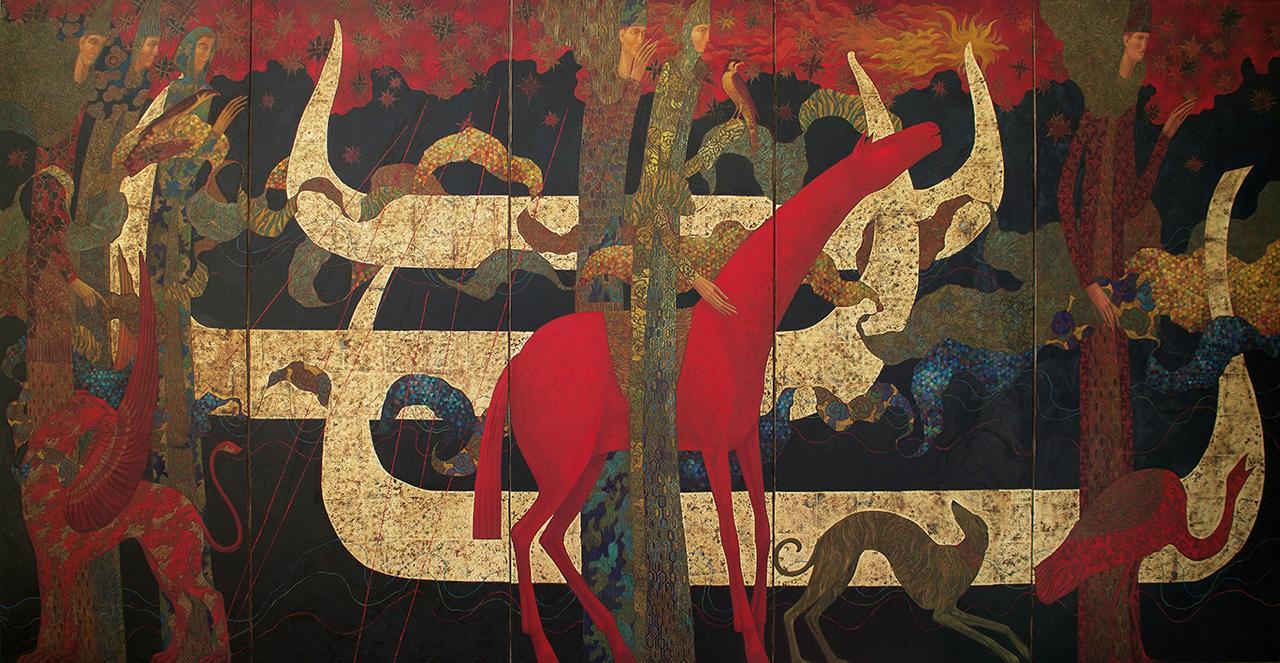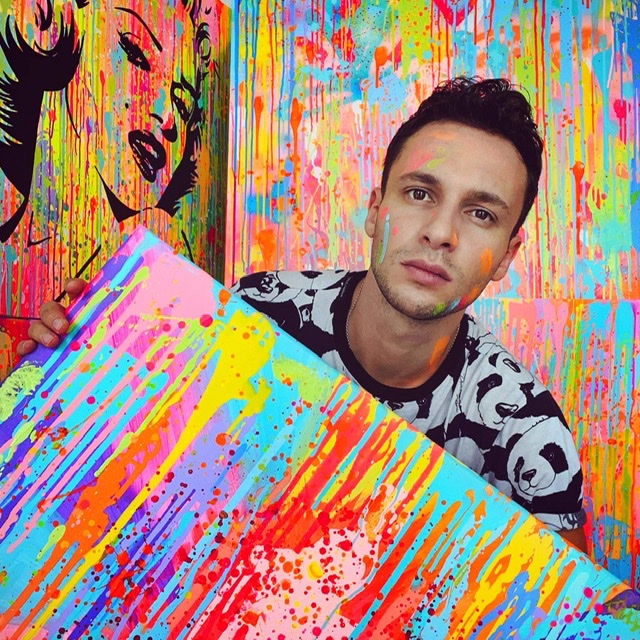Maie El-Hage is an architect and art historian, with a Master of Arts degree in Art History and Theory from the University of Essex in the UK, and a Bachelor of Architecture degree from the American University of Beirut. She is currently working in Talent Management, and is the region’s representative of several Arab and European artists. Based in Beirut, Maie teaches Art History and Architectural Drawing courses at the Lebanese American University. We had a chance to interview Maie and learn more about her journey and get the insights on the art scene in Lebanon.
What is Art to you?
I see Art as a reflection of our culture, identity and history. We live in a time when art has the capacity to be transcultural, to cross borders. This was not always the case. Civilizations of the past tended to retain their identities, and therefore their artistic styles and practices, with crossovers with other civilizations. As historians, we can study and trace these crossovers.
Examining Art of the past, (specifically pre-1960), and understanding Contemporary Art today are two different activities, and thanks to my profession, I get to do both.
I love Art because it is an experiential activity that an Artist, a creator, gets to share with his/her audience. The Artist engages his/her philosophy, search for meaning, and/or exercise of skill in the creative process. Understanding the complexities of this process is one of my passions in my job.

What made you pick Art History as your major?
I was very fortunate to be blessed by a rich and interdisciplinary education at AUB (the American University of Beirut) as an undergraduate architecture student. In addition to the drawing and design courses, I was enrolled in four comprehensive Art and Architectural history courses, in addition to two elective Art history courses. The AUB faculty delivered courses that encouraged critical thinking. The richness of the material remained with me into my professional life, and when it was the right time for me to pick my Graduate degree major, it was a no-brainer. I wanted to be part of the conversation.
Upon my application to the University of Essex in the UK, I was awarded the Drake-Lewis Scholarship; I earned my MA degree in Art History and Theory and graduated with Merit.

What has your journey been like professionally ?
I first started working with artists Paolo Ghezzi and Nadia Antonello (the artistic duo of Antonello Ghezzi, based in Bologna) in March 2018. I was hired as the PR assistant for their representation at the Art Bahrain Across Borders, International Art Fair 2018. It was a beautiful experience as I met artists, gallerists and journalists, working and collaborating in many different ways. I learned a lot from that experience.
One year later, I curated a live contemporary art show for Antonello Ghezzi at MACAM, Modern and Contemporary Art Museum in Alita, Byblos. It was a sound project turned into a concert for the public, held on a beautiful early October evening in 2019. It was one week before the revolution.
Since then I have curated more art shows in Beirut, before the lockdown, during the lockdown (online), and after the lockdown was lifted. I believe that the effort my artists and I are making to keep the art scene alive is a sign and example of resilience.
As for my journey as a writer, my first art historical article published was also in 2018 in Harper’s Bazaar Arabia Art (available online). I interviewed the Syrian artist Thaier Helal after seeing his exhibition Landmarks at Ayyam Gallery in 2017, the article is titled “Syrian Artist Thaier Helal on Landmarks from Memory and Exploring Abstraction”.
Since then I have published two more articles with Harper’s Bazaar Arabia Art, one of which was published in print (“Studio Visit: Encountering Expression” interviewing artist Tagreed Darghouth – Spring 2019 Harper’s Bazaar Arabia ART, Issue #34) as well as articles with other venues like HOME Magazine for Lebanon, Decoventure.com, and National News Agency (for my Arabic articles). I also publish articles of my musings and travels on my LinkedIn page.

How does understanding history of art help you to connect with the contemporary art?
I have researched, written and compiled teaching material for University courses including History of Arts, History of Architecture, History of Art and Architecture, History of Interior Design, History of Graphic Design, Art Appreciation, History of Photography, and an Introduction to Art History, over my teaching career. Being knowledgeable about history in those different disciplines informs my observation and understanding of Contemporary Art today.
Artists early in their careers immerse themselves in research, and learn from their predecessors. My knowledge about art movements of the past informs my understanding of contemporary artists today, and their own research processes.
How can you describe the art scene in Beirut and Lebanon in general?
Beirut is a wonderfully vibrant city, and Lebanese people love life, art and culture. We are currently, however, going through a crisis on many scales, politically and economically, in addition to the global pandemic. The Lebanese people want meaningful change, stability, and security. Many contemporary Lebanese artists express the concerns and frustrations of the Lebanese citizens through their art. Art tends to be a reflection of the individual and collective experiences. We hope that Lebanon emerges from these crises like the Phoenix emerges from the ashes. I believe in my country and in the people of my country.

What are the most important art galleries or art centres?
Sursock Museum in the heart of Achrafieh and the National Museum (Mathaf) are two of my favourite Beirut museums, and a must-see for any visitor. If you want to venture outside the capital, do pass by MACAM (Modern and Contemporary Art Museum) in Alita, Byblos, with its beautiful sculpture garden. There are many active galleries in Beirut, and you can read more about them in my upcoming article ’10 Beirut art galleries you should visit on your next trip to Lebanon’ (Summer 2020). Saleh Barakat Gallery, Agial Art Gallery, 392Rmeil393 gallery, Art on 56thGallery, and Galerie Tanit, are important cultural hubs, many of which have programs that support local artists. These local galleries have a broader, cultural project that enriches the art scene in Beirut, and this is important. In downtown Beirut, Opera Gallery is part of a chain of galleries located worldwide, including Dubai. There are more, wait for my article!
What constitutes Lebanese art?
I’d like to draw distinctions between Post-Medieval, Modern and Contemporary art practices. We cannot lump them all in one category titled ‘Lebanese art’. If we start our benchmark at the year 1860, let’s say, we will find a Lebanese artist like Daoud Corm as a pioneer of Lebanese painting. Him and Habib Serour, one of his contemporaries, were educated in Rome. These artists were followed by artists of the French Mandate period. Of this category, Gibran Khalil Gibran is the most notable. Khalil Gibran is the Lebanese artist par-excellence; a writer, an excellent draftsman, and a lyrical painter who expressed timeless themes of love, beauty and the meaning of our existence. Later in modern history, Lebanese artists like Saloua Raouda Choucair, Helen Khal, Aref El Rayess and Paul Guiragossian brought about ventures into a more Avant-Garde realm of art. These artists were the contemporaries of the New York School and Abstract Expressionism of the 40s, 50s and 60s. The overlaps between our history and Western art history are fascinating.
Is it difficult to be a professional artist in Lebanon?
Our Lebanese Constitution Article 13 protects Freedom of Speech, (and Freedom of the Press.) Throughout most of our modern history, artists, writers, and journalists have tended to express their opinions, as protected by the Constitution. This has enriched the culture and awareness of Lebanese citizens, especially the Youth. It is a Freedom that needs to be protected and maintained.
There are several cultural bodies that support artists in Lebanon. AFAC Arab Fund for Arts and Culture have grants and programs that support artists. Askhal Alwan, a Lebanese non-profit organization, has programs, forums and residencies that help support artists and facilitate contemporary art practices. More regionally, Art Jameel or Jameel Arts Centre based in Dubai has grants that award artists, art projects and art researchers in the region.

How do you represent artists?
I work with artists whose work I believe in. I secure for them exposure, either locally or abroad, through exhibitions, participation in fairs, shows, workshops, etc. I provide online promotion and publishable material. I currently work and travel between Beirut and Dubai, and am looking to branch out to Istanbul in the near future. I have experience working with European art fairs and workshops as well. My role is to support the artist by managing branding, marketing and Public Relations. In this way, the artist can focus on creating art.
I am currently representing the following, very talented artists: Rabih Ibrahim, a Lebanese art photographer based in Abu Dhabi; Myriam Ghali, an established artist currently living in the USA; Antonio Pauciulo, an Italian painter based in Germany; Antonello Ghezzi artist duo based in Bologna; Wissam Melhem, a Lebanese emerging artist; and Dr Ralph Hage, a Lebanese digital artist and professor.

What is your advice to someone trying to build a career in art?
I would say, work for what you believe in. Develop your skill. Learn. Go to art shows. Educate yourself. And don’t be afraid to be passionate and try something new. Don’t give up when things get tough. Make connections. Any venture is a learning process, and a career in art is a long-term process with beautiful moments and encounters. Go for it!
Follow Maie’s FB page Art Historian Maie and @Maie.Art on Instagram to be updated on the latest events and news in the art scene of Lebanon and beyond.



